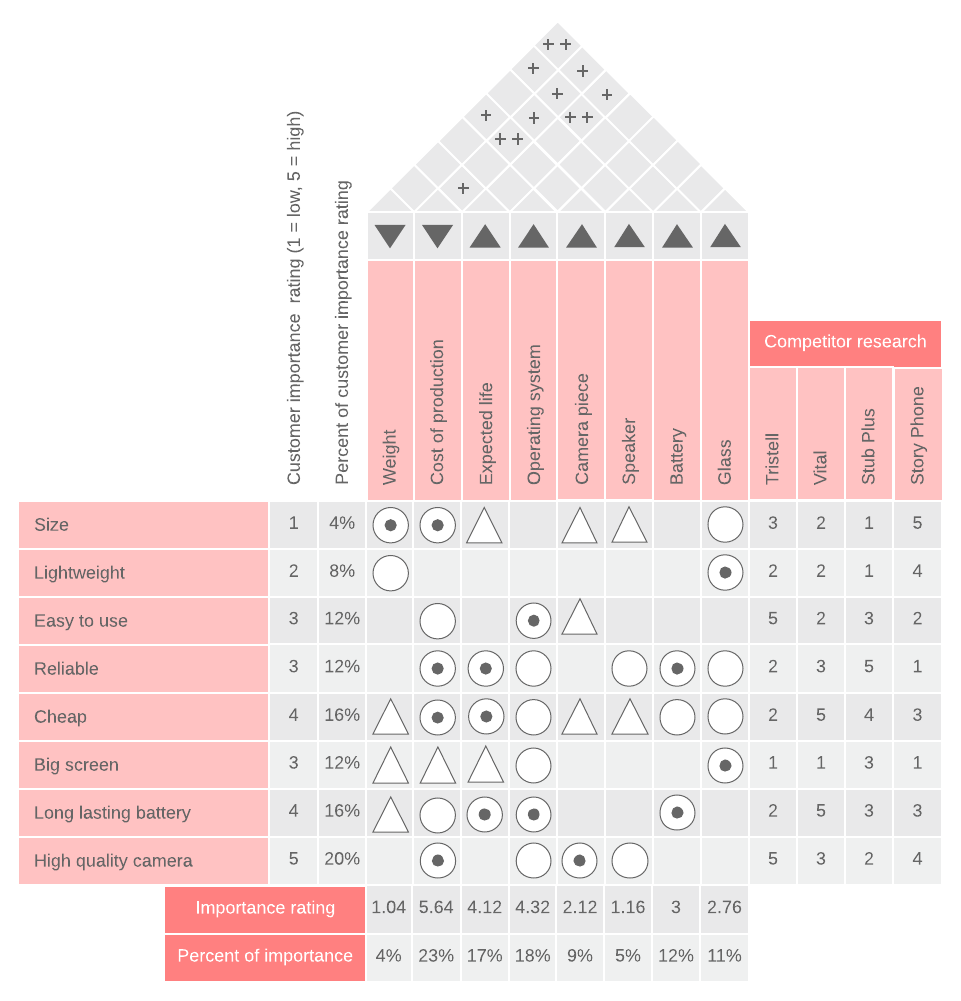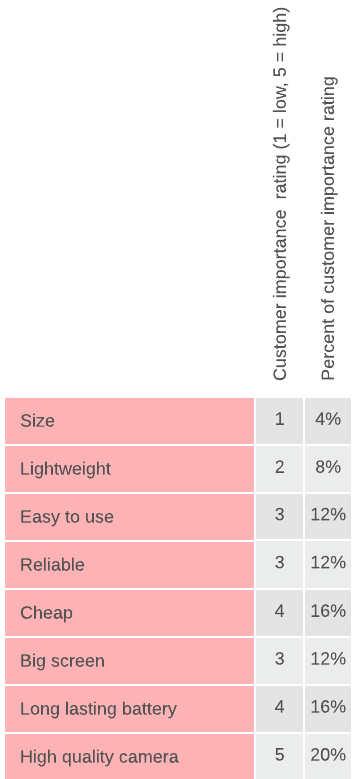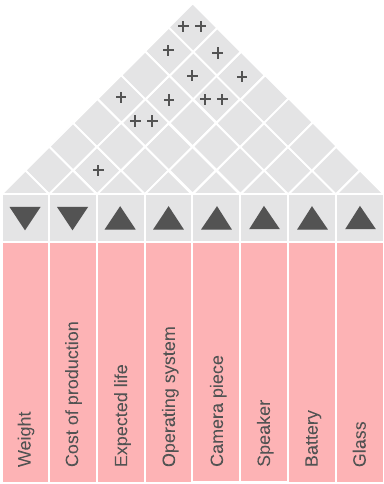
How to build a House of Quality (QFD)
Reading time: about 7 min
Every product aims to fill a specific customer need, but pinpointing what customers actually need is more difficult than it seems. Without a clear understanding of the customer’s pain points, the development process can become bloated, misguided, or simply doomed from the start.
Quality function deployment (QFD) is a methodology created in response to this problem. It’s focused on providing a clear framework for addressing customer needs, beginning with a matrix called the House of Quality. Read on to learn more about QFD and how our House of Quality template can help you develop a product that resonates with customers.
What’s quality function deployment?
Quality function deployment. It’s a very technical-sounding name for a process that essentially helps businesses integrate the Voice of the Customer (VOC) into product development. This methodology can provide many benefits.
Understand customers
Often, customers don’t even know what they want or need. The quality function deployment aims to understand customers better than they know themselves.
Predict how customers will perceive a product’s value
Understanding how customers will judge your product’s value is key throughout the entire development process. They may not see its value how you see it.
Obtain buy-in from stakeholders
All areas of the organization need to be informed about the customers’ needs so that they can create processes for developing, marketing, and selling to those needs.
Use customer needs to develop goals
Without determining performance goals, there’s no way to measure how well the product is fulfilling customer needs. Consider performance metrics (or “Critical to Quality” metrics aka CTQs), concepts, design characteristics, process parameters, and production controls.
Document requirements
This benefit should speak for itself: Without documenting the requirements, customer needs are simply a game of telephone that can be misinterpreted from department to department.
Provide structure
The front end of product development can become quickly mired in inefficiency. QFD provides logic and structure so development can take a deliberate approach.
Prioritize resources
QFD will allow you to pinpoint areas most critical to the customer and bottom line, then allocate resources properly to those areas.�
As you can see, each aspect of the QFD is pointed toward the same “north star”—what your organization understands as your customers’ needs, based on feedback from surveys, focus groups, interviews, etc. Those customer needs are the directions your organization must follow to develop a successful product.
Phases of the QFD process
The entire QFD process is much more involved than we’ll get into in this article, but here are the basic steps:
- Product definition: This phase involves gathering VOC (through interviews, focus groups, and related methods) and determining how those customer requirements translate into product features or design requirements. The House of Quality fits into this stage. As you define the customer requirements, you’ll begin mapping them to your House of Quality template.
- Product development: During this phase, teams will translate the product specifications prioritized in the House of Quality into part and assembly characteristics and define functional requirements.
- Process development: During this phase, the company will design manufacturing and assembly processes to fulfill the House of Quality product specifications.
- Process quality control: Finally, those using the QFD process will identify critical characteristics and develop controls, inspections, and tests to ensure that those characteristics are met.
What is the House of Quality?
What is the House of Quality?
The QFD House of Quality is a voice of the customer analysis tool. Through multiple factors, including competitor research and the level of importance of each customer need, you can determine which product specifications take priority.

How to use the House of Quality template
Let’s walk through the process of putting together a House of Quality using a QFD example for a company building a new smartphone.
1. Add customer needs and ratings
On the left side of the House of Quality, you’ll enter the most important customer needs based on your research. For instance, in this House of Quality example, customers care about the following qualities when shopping for a smartphone:
- Size
- Weight
- Easy to use
- Reliable
- Cheap
- Big screen
- Long-lasting battery
- High-quality camera
Next to the customer needs you have listed, rate how important each requirement is on a scale of 1 to 5. Customers may rate several traits of high importance, so it’s okay to have multiple 5s or multiple 4s. Ratings don’t have to be whole numbers either.
To the right, you’ll calculate the percent of customer importance rating for each requirement. Take the rating given to a requirement (1 to 5) divided by the total of all ratings.

2. List design requirements
Horizontally above the relationship matrix, you’ll add design requirements for the product, such as weight, cost of production, and operating system.
3. Weigh the relationship between customer needs and design requirements
In the relationship matrix, you’ll identify how strongly each of the design parameters affects the customer need. Use the following symbols:

As an example, if customers would like a less expensive smartphone, the cost of production will strongly contribute to the price. The operating system, battery, and glass used in the product will also affect the overall cost to customers, but not as strongly.
Once you have filled the relationship matrix, you can add the importance rating and percent of importance for each design requirement. To calculate the importance rating, multiply the percent of importance rating with the relationship score for each customer need. (In our House of Quality example, “size” has a 4% customer importance rating and a 9 relationship score, so the total would be 0.36.) Add those totals together for the importance rating.
After you calculate all the importance ratings, you can take each rating divided by the total for your percentages. The requirements with the highest importance ratings or percentages are likely the features that your company should prioritize or invest in more.

4. Complete the correlation matrix
The correlation matrix will determine how design requirements help and hinder each other.

Above each design requirement, you’ll mark whether it’s better for the feature to be lower (down arrow) or higher (up arrow). For example, it would be preferable for the weight of a smartphone to be lower, so the example includes a down arrow. On the other hand, it would be preferable for the battery to be higher (last longer), so the House of Quality example includes an up arrow. These ratings are up for interpretation.
Based on these up-and-down symbols, you’ll determine the correlation between different design requirements. Use the correlation matrix legend to designate these relationships using the appropriate symbol (placed in the square between two features).

For example, the operating system will greatly affect the expected life of the smartphone. Since both have up arrows, the two features have a strong positive correlation.
5. Add competitor research
Finally, the competitive assessment shows how companies currently rank for each of your customers’ needs so you can determine what has been overlooked and how you can gain an advantage over your competition.
The correlation matrix and competitor research do not affect the importance ratings, but they do provide additional insight to help you weigh which customer needs and design requirements matter most.
That’s it! Your QFD House of Quality is now complete. This will be your guiding matrix for determining what your product absolutely must have to appeal to your customers’ needs and wants. It will also be a useful tool in documenting the Voice of the Customer and keeping all processes on track throughout production.
Why do teams use QFD?
QFD and the House of Quality might seem like a lot of work, but QFD is a good option if any of the following apply to your business:
- Customer satisfaction is a main goal for your organization.
- There have been delays in development.
- There is poor interdepartmental communication about customer needs.
- Product and process decisions have not had clear guidelines.
- There is no clear, documented product definition.
- You are entering a new market.
- The product is not performing as well as it had been expected to.
- The product is becoming a commodity or people already view it as a commodity.
- You have more than one customer with differing needs.
Consider, too, that the longer it takes to develop a product and bring it to market, the more resources are invested in development. It is only a benefit to your organization to make the development process faster and more efficient.

Try filling out your own House of Quality template.
Start nowAbout Lucidchart
Lucidchart, a cloud-based intelligent diagramming application, is a core component of Lucid Software's Visual Collaboration Suite. This intuitive, cloud-based solution empowers teams to collaborate in real-time to build flowcharts, mockups, UML diagrams, customer journey maps, and more. Lucidchart propels teams forward to build the future faster. Lucid is proud to serve top businesses around the world, including customers such as Google, GE, and NBC Universal, and 99% of the Fortune 500. Lucid partners with industry leaders, including Google, Atlassian, and Microsoft. Since its founding, Lucid has received numerous awards for its products, business, and workplace culture. For more information, visit lucidchart.com.
Related articles
A quick guide on user story mapping
Learn about user story mapping and how you can take advantage of user story maps to plan a more effective customer experience. Free templates included!
How to create a customer journey map
Customer journey maps are a powerful tool for understanding your customer's experience and adapting to meet their needs. Learn how to create a customer journey map (we even have free customer journey map templates available!).
